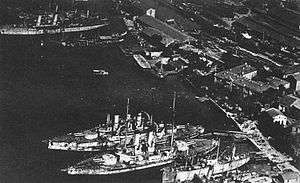Crimea Operation (1918)
| Crimea Operation (1918) | ||||||||
|---|---|---|---|---|---|---|---|---|
 | ||||||||
| ||||||||
| Belligerents | ||||||||
|
|
|
| ||||||
| Commanders and leaders | ||||||||
| Robert Kosch | Petro Bolbochan | Anton Slutsky | ||||||
The Crimea Operation took place in 1918 in the Crimean Peninsula between the occupying German army, Ukrainian People's Republic and parts of Red Army.
The operation
With the assistance of the German Empire, the Taurida Soviet Socialist Republic was quickly overrun by forces of the Ukrainian People's Republic under command of Petro Bolbochan during the Crimean Offensive.[1] By the end of April 1918, the majority of the CEC and the Council of People's Commissars, including council leader Anton Slutsky and local Bolshevik chief Jan Tarwacki, were arrested and shot in Alushta by insurgent Crimean Tatars. On 30 April, the Republic was abolished.

The goal of both Ukrainians and Germans was to get control over the Black Sea Fleet, anchored in Sevastopol. Former Chief of Staff Mikhail Sablin raised the colours of the Ukrainian National Republic on 29 April 1918.[2] and moved a portion of his fleet (two battleships and fourteen destroyers) to Novorossiysk in order to save it from capture by the Germans. He was ordered to scuttle his ships by Lenin but refused to do so.
Most ships returned to Sevastopol, where they first came under German control, until November 1918 when the came under Allied control who later gave the ships to the White Russians (See Wrangel's fleet).
See also
References
- ↑ (in Ukrainian) Hrabovsky, S. Три місяці свободи, The Ukrainian Week. 19 February 2008.
- ↑ Operation Fleet For Ukraine, The Ukrainian Week (16 May 2011)